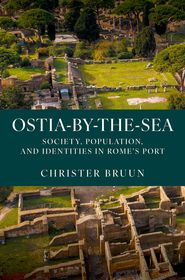
Ostia-by-the-Sea
Society, Population, and Identities in Rome's Port
-
10% KEDVEZMÉNY?
- A kedvezmény csak az 'Értesítés a kedvenc témákról' hírlevelünk címzettjeinek rendeléseire érvényes.
- Kiadói listaár GBP 97.00
-
46 341 Ft (44 135 Ft + 5% áfa)
Az ár azért becsült, mert a rendelés pillanatában nem lehet pontosan tudni, hogy a beérkezéskor milyen lesz a forint árfolyama az adott termék eredeti devizájához képest. Ha a forint romlana, kissé többet, ha javulna, kissé kevesebbet kell majd fizetnie.
- Kedvezmény(ek) 10% (cc. 4 634 Ft off)
- Kedvezményes ár 41 708 Ft (39 722 Ft + 5% áfa)
Iratkozzon fel most és részesüljön kedvezőbb árainkból!
Feliratkozom
46 341 Ft

Beszerezhetőség
Még nem jelent meg, de rendelhető. A megjelenéstől számított néhány héten belül megérkezik.
Why don't you give exact delivery time?
A beszerzés időigényét az eddigi tapasztalatokra alapozva adjuk meg. Azért becsült, mert a terméket külföldről hozzuk be, így a kiadó kiszolgálásának pillanatnyi gyorsaságától is függ. A megadottnál gyorsabb és lassabb szállítás is elképzelhető, de mindent megteszünk, hogy Ön a lehető leghamarabb jusson hozzá a termékhez.
A termék adatai:
- Kiadó OUP USA
- Megjelenés dátuma 2025. december 17.
- ISBN 9780197635353
- Kötéstípus Keménykötés
- Terjedelem1088 oldal
- Méret 235x156 mm
- Nyelv angol
- Illusztrációk 135 b/w 700
Kategóriák
Rövid leírás:
Ostia, the Roman settlement founded at the mouth of the river Tiber, was the port of the imperial capital and one of the most important urban centres in the Mediterranean world during the last decades of the Roman Republic and the Early and High Empires. Christer Bruun, an internationally recognized authority on Ostian society and culture, uses his mastery of contemporary scholarship and ancient sources to present a novel and often surprising analysis of what these testimonies can tell us about the people who lived there, or merely visited, or those whose ships anchored in one of Ostia's harbors.
TöbbHosszú leírás:
Ostia, the Roman settlement founded at the mouth of the river Tiber, was the port of the imperial capital and one of the most important urban centers in the Mediterranean world during the last decades of the Roman Republic and the Early and High Empires. The town's role as a maritime mercantile hub explains why, in its heyday, it was Italy's largest town after the mighty Rome. Ostia is still important today, but now because of the impressive remains of its buildings, inscriptions, and even more numerous archaeological objects--and what they can tell us about the people who lived there, or merely visited, or those whose ships anchored in one of Ostia's harbors.
How did migration, slavery, new religions, and the hard work in the harbors impact Ostia's inhabitants during the period 50 BCE-250 CE? How did these populations behave, and what did they think of themselves, the surrounding world, and their place in it? To answer these questions, Christer Bruun uses his profound knowledge of international scholarship and his mastery of thousands of primarily Latin inscriptions. Initially, he focuses on how the physical environment impacted the inhabitants by studying how neighborhoods created social bonds, what monuments can tell us about cultural memory, and how Ostia's maritime atmosphere impacted this population's consciousness. He then analyzes ideological trends within specific segments of the population--senators, women, the freeborn municipal elite, Augustales and freedmen, and the general population (free, slaves, immigrants)--to better answer questions about their evolving identities. Who were they, beyond their legal and formal distinctions? Bruun's answers to this question are often unexpected. For example, Ostia's women, he argues, had more opportunities there than anywhere else in the Roman world. This ambitious history of a town that was constantly changing, always in flux, reveals elements of an "Ostian" ideology, but also leaves readers with clear signs of conflict among these ideas, opening previously unimagined dimensions of life in Ostia.
Tartalomjegyzék:
Ostia: Population, Society, and Identities
Fundamental Structures of Ostia and of the Ostian Polity
Local Emotions, Attachments, and the Organization of Space and Population
Memoria and History at Ostia
Extending Many Hands in Friendly Welcome to those Arriving from the sea: The Maritime Atmosphere
Ostia Open Town-For Senators. who Ran the Place?
The Municipal Elite
Civic Spirit Among the Augustales and other Sub-Elite Groups
The Ordinary People of Ostia: Provocative Questions
Ostia: A City of Women and Children?
The Roman Emperors and Ostia
Occupations, Work, Identities: Some Aspects of the Ostian Economy
Mobilizing the Ostian Population
Conclusions. More Than A Rome In Miniature: A New World




